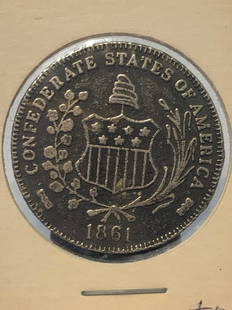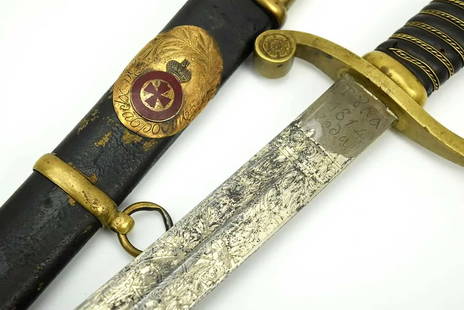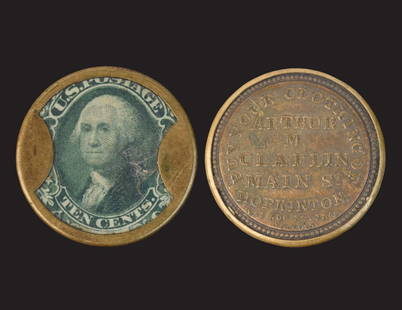
1860 RARE SCALLOPED FLAT RIM REDWARE BUNDT CAKE MOLD XZ
Similar Sale History
View More Items in Militaria & War MemorabiliaRelated Militaria & War Memorabilia
More Items in Militaria & War Memorabilia
View MoreRecommended Collectibles
View More








Item Details
Description
We are proud to present this gorgeous ca. 1860’s to 1910 American Virginia, Pennsylvania, Maryland and New York glazed Redware Bundt Cake and Jelly / Aspic molds, diversely formed and in excellent condition. Though many of these stunning molds appear very similar, we have attempted to attribute them to a style of an area whenever possible. All of our examples are in VG-Excellent condition, and unless stated to the contrary, are exceptional antique pottery! This example features a handsome & Rare 1860's Turk’s cap Bundt Cake mold, with an outstandingly crisp detailed spiral interior pattern, and a classic English scalloped & flattened highly eccentric rim, and a semi-vitreous deep brown Rockingham colored glaze. The condition of this fine American antique is VG, and almost assuredly was potted in the New England region. This great Bundt mold bowl measures 8.5 x 8.5 x 3.25" tall and weighs a substantial 3#. **** Collector’s note: Turk’s cap molds were very often slip cast and if not finished in the classic transparent glaze, were finished in either a traditional English Rockingham, or a unique manganese splotched glaze. Another & rare form of finish entailed a rich Olive green / copper-lead glaze. Examples have been identified to potteries such as Perine Pottery in Baltimore, John Bell of Waynesboro, Pa., Alvin Bell of W. Bloomfield, N.Y., and Clark & Fox of Athens N.Y. Research consulted: Redware: America's Folk Art Pottery Paperback / by Kevin McConnell; American Redware / by William C., Jr. Ketchum; Early New England Potters And Their Wares / by Lura Woodside Watkins. xxxxxxxxxxxxxxRedware pottery, which is just what the name implies, a reddish brown colored pottery, was first made by English settlers in the 1600’s. Redware pottery was made in many different states including, Virginia, Pennsylvania, New York and Tennessee. The reason it is that color is because of the iron content of the clay that was used to produce the pottery. The shades of red or brown can vary greatly depending on where the clay came from and how much iron is in the clay. Antique Redware pottery from colonial times can be found to be in most cases rough and usually of poor quality. Higher firing temperatures were not used because the iron-rich clay would melt, and also, as the clay is porous, red ware must receive a secondary over glaze to achieve a proper seal to the pottery, or if you will to achieve a semi vitreous state. Early Colonial Redware was very inexpensive to produce, with rudimentary applied colors, and typically sealed with a simple transparent lead glaze, which was used in conjunction with a slip undercoat sealer. xxxxxxxxxxxxxx. The earliest settlers in New England imported most of what they needed from England, but pre Revolutionary Redware pottery was one of the first necessities they made for themselves. They had a strong British Redware tradition to draw on, as red clay deposits were plentiful lead for the glaze was also readily available, and all that was needed for equipment was a potter’s wheel and a kiln capable of firing at the relatively low temperature of 1,800-1,850 F. The first recorded potter in New England was John Pride, who was working in Salem, Massachusetts by 1640, but he was preceded by anonymous and unrecorded others. The pre 1776 restrictions imposed on the English Settlers by the British crown in the 18th Century, required all quality raw materials to be sent England where the clay would be turned into well designed and fancy pottery. The pottery would then be sent all over the world, including the colonies here in America. It was unlawful for potters to produce their own products lest the crown not make a huge and handsome profit on the shipment, production and re-shipment of product. Although potting was unlawful, Redware was exempt, as it was considered as strictly utilitarian wares in England, and posed no threat to English exports or profits. Some colonists continued to make their own pottery and it was tolerated because the merchandise was of inferior quality to the pottery made in England. After the War of Independence, many potters came to the United States from England and later other countries such as Germany and produced better quality products that were able to compete with the English potters. xxxxxxxxxxxxx Germans & English influenced pottery in the Northern states, while English artisans were joined by Africans and Germans creating pottery in the South. The Germans in Pennsylvania made decorated pottery from the mid-18th to the 19th century, using techniques from their homeland in the Rhine district. Using local yellow clay, they made sgraffito and straight slip decorated molded pottery (with lead glazing), whereas semi-liquid clay or slip was used both as a wash before firing and, when thicker with a pressed relief decoration. Sgraffito refers to a technique of cutting away the surface layer to reveal a different base color. Early Southern potters used time honored English firing & design techniques, which produced shapes that were more ovoid, with rounded shoulders. The trend through the 19th century was towards shapes showcasing more generally rounded, then straighter vessel forms. Pre-Civil War earthenware & Redware was of higher quality than later efforts, owing to the demise of the exemplary small regional Plantation potteries that were quite sophisticated & proud of their finished products. The quality decline was further fueled by the faster cheap production brought about the end of the Civil War, with Alkaline and slip glazing the most common finishing techniques in the Old South *** Weight: 3# - Measurements: 8.5 x 8.5 x 3.25" tall
Condition
Very good condition - minor wear and glaze pits, center spindle chip
Buyer's Premium
- 13% up to $100.00
- 13% up to $10,000.00
- 13% above $10,000.00
1860 RARE SCALLOPED FLAT RIM REDWARE BUNDT CAKE MOLD XZ
Estimate $120 - $145
Shipping & Pickup Options
Item located in SHEFFIELD, AL, usSee Policy for Shipping
Payment

TOP

































![[CIVIL WAR]. COOLEY, Sam A., photographer. Exceptionally rare stereoview of photographer Sam A.: [CIVIL WAR]. COOLEY, Sam A., photographer. Exceptionally rare stereoview of photographer Sam A. Cooley and his staff in the field. 6 x 3 in. stereoview on cardstock mount (superb condition). App](https://p1.liveauctioneers.com/197/250551/130130009_1_x.jpg?height=310&quality=70&version=1654185975)






















![George Washington Signed Discharge: Partly printed discharge document signed by George Washington, as Commander in Chief of the Armies of the United States. Newburgh, [New York], 4 January 1783. 1 page, ## x ## in. Undersigned by Washin](https://p1.liveauctioneers.com/7226/322253/173251475_1_x.jpg?height=310&quality=70&version=1710004847)
![Captured Bowie Knife w/ Period Note of Provenance: Captured Confederate D-hilt Bowie knife. [Kenansville, North Carolina]: [Louis Froelich factory]. With original metal and leather sheath with affixed period notes. First note with only remnants. Secon](https://p1.liveauctioneers.com/7226/325455/175169154_1_x.jpg?height=310&quality=70&version=1712370394)
![[Ambrotype] Texas Confederate Soldier: Sixth plate ambrotype. Full leatherette case. Portrait of a possible Texas Confederate soldier. A silver star device was used to pin up the brim of his light-toned headgear, a look often seen in image](https://p1.liveauctioneers.com/7226/322253/173251509_1_x.jpg?height=310&quality=70&version=1710004847)
![[CIVIL WAR] 1st Texas Infantry in Camp: Outdoor half plate ambrotype of the 1st Texas Infantry. Full leatherette case. Significant, large half plate ambrotype of members of the 1st Texas Infantry at ‘Splinterville,’ the regiment’s win](https://p1.liveauctioneers.com/7226/322253/173251512_1_x.jpg?height=310&quality=70&version=1710004847)
![[HANCOCK, John] Washington’s Spy, Officer’s Commission: Partly printed document signed by John Hancock as President of the Continental Congress, for Epaphras Bull (1748-1781). [Philadelphia, Pennsylvania], 10 January 1777. 1 page, ## x ## in. Completed in](https://p1.liveauctioneers.com/7226/322253/173251471_1_x.jpg?height=310&quality=70&version=1710004847)
![[CIVIL WAR] Black Soldier & Wife: CDV-sized tintype photograph WITH gem-sized tintype. Full thermoplastic case. Portrait of an unknown African American Civil War soldier who holds the rank of sergeant. He looks directly at the camera](https://p1.liveauctioneers.com/7226/322253/173251671_1_x.jpg?height=310&quality=70&version=1710004847)
![[Civil War] Bullet Which Nearly Killed Soldier: Lead bullet encased in gold acorn fob with chain. Finely engraved: "W.D. Fiske / 14th Regt. C V / Fredericksburg / Dec 17, 1863." Acorn approx. 1 1/2 x 1 in. Overall length 6 1/2 in. Published in "Her](https://p1.liveauctioneers.com/7226/325455/175169103_1_x.jpg?height=310&quality=70&version=1712370394)
![Historic Einstein Signed Program from Lincoln University Visit: Conferences on Objectives. Lincoln University, [Oxford], Pennsylvania, 3 May 1946. SIGNED BY ALBERT EINSTEIN. Tipped into Horace Mann Bond (1904-1972). The Education of the Negro in the American Socia](https://p1.liveauctioneers.com/7226/322253/173251693_1_x.jpg?height=310&quality=70&version=1710004847)

![[CIVIL WAR] Presented Ames Sword, 16th New York Light Artillery : Fine m1850 foot officer's sword presented to Lieutenant Henry C. Jackson, 27th New York Infantry and 16th New York Light Artillery. Solingen, [Germany]: W. Clauberg and Ames, Chicopee MA hallmarks. Re](https://p1.liveauctioneers.com/7226/325455/175169097_1_x.jpg?height=310&quality=70&version=1712370394)
![[Civil War] 1862 “Servant” Slave Badge: Charleston, South Carolina "slave badge,” dated 1862. From the workshop of William Veronee, by city contract. This example was issued for a “Servant," typically a designation used to describe](https://p1.liveauctioneers.com/7226/322253/173251645_1_x.jpg?height=310&quality=70&version=1710004847)









